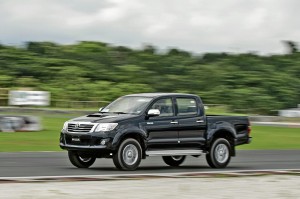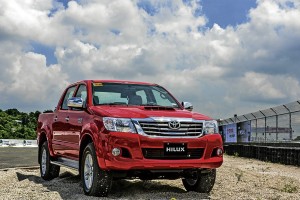Toyota Fortuner and Hilux get very welcome boost in power and several exciting upgrades
Toyota Motors Philippines recently unveiled improved variants of the current model Fortuner SUV and Hilux pickups. Both models sparked the country’s diesel revolution with their introduction almost eight years ago, inspiring the industry handbook in the design of a highly versatile platform that, with minor changes, can be made into a pick-up, SUV or MPV platform. Out of this platform emerged the Toyota IMV or International Innovative Multipurpose Vehicle.
However, competitors have caught up by offering better-priced, better-spec’d and better-performing vehicles in the market particularly in the power and interior accouterments departments, respectively.
Toyota’s 2.5-liter D4-D engine (internally codenamed 2KD-FTV) got a very welcome boost in power, from the previous 102 hp to now 144 hp—up by 42 hp, or 40 percent. Torque is up 30 per cent, now totaling 343 Newton-meters. There is no bump in power for the 3.0 D4-D engine (codenamed 1KD-FTV) but sees a flatter torque curve, similar in output to the smaller 2KD-FTV of 343 Newton-meters of torque that peaks earlier and carries through closer to redline. On the world-class Clark International Speedway, the changes seem much more significant than the indicated zero increase in power.
Visually, the Fortuner and Hilux 3.0-liter V variants have no major cosmetic change. But the 2.5 D4-D variants now present the massive hood scoop to chill the top-mounted intercooler,

THE FIRM suspension of the Hilux and Fortuner allows for almost flat-out cornering through the sweepers.
previously unavailable for the lower-engined diesel variants.
Article continues after this advertisementNew colors are also available for the Fortuner, namely “Silky Gold Mica Metallic,” “Lithium,” “Dark Grey,” “Dark Steel Mica Metallic,” “Xtreme Black” and a special order “White Pearl.” On the other hand, aside from the color options listed above, Hilux has “Freedom White” and “Super Red.”
Article continues after this advertisementThere are also a lot of significant changes in the insides of the Fortuner and Hilux. A new design steering wheel, similar to the one used in the previous-generation Camry executive luxury sedan, is now fitted, with auxiliary controls for the multimedia system and equipped with an SRS airbag. The aforementioned multimedia system has satellite navigation, CD-DVD/MP3 player and mobile phone integration capability to offer hands-free telephone communication. It is also able to accept USB flash drives for music/data and connection with your MP3 device along with an auxiliary input jack.
This comes as a timely update for the aging IMV platform as key competitors have recently launched fresher, newer products to compete head-on with the Fortuner and Hilux. With an all-new IMV platform replacement rumored to appear sometime between 2015 and 2016, these changes help spur the Fortuner and Hilux forward with an extended lease on life.

TMP PRESIDENT Michinobu Sugata said Toyota’s IMV lineup is now strengthened with the addition of turbocharged variants.
Pundits and critics might argue that once again Toyota is still conservative by not offering a 5-speed automatic with self-shifting manual mode option or xenon/HID/LED lights to conform to the prevailing mode, or changing the overwhelming beige interior into a cooler, more sophisticated hue. No doubt these changes would have won the Toyota duo more fans, but Toyota seems to be slowly but surely stretching its possible menu of upgrades precisely to increase the IMV platform’s lifespan until the all-new replacements come in a few years.
Out on track, little of these criticisms matter as both the Fortuner and Hilux displayed admirable mixed-surface performance. The 2.5 D4-D variants, with the automatic in particular, have highly impressive mid-range grunt that is more than adequate to propel the heavy Fortuner down CIS’ main straight at impressive speeds. The firm suspension allows for almost flat-out cornering through the sweepers, but be mindful of the FIA regulation curbing as the firm suspension lacks compliance to tame the rear-end. Some of the drivers who attempted curb-running the Fortuner to get it faster through the clipping points experienced some hairy two-wheeled moments reminiscent of Russ Swift’s 2-wheeled stunts. The brake pedal is softer than I remember, and takes a bit of getting used to, to properly modulate the brakes and prevent locking up and triggering the ABS before turning into the fast sweeping corners.
In comparison, the Hilux’s manual transmission, mated with the 5-speed manual provided even more impressive off-the-line acceleration and better control through the turns. The even lighter rear-end meant that transitioning from the muddy dirt section going to the tarmac surface meant for a bit/a lot of slippery sideways action, depending on how aggressive you got on the throttle after passing the clipping point of the apex. The impressive on- and off-road performance balance is one of the IMV platform’s strong traits as it offers just enough of both performance parameters easily accessible to the average driver, yet maintains a high level of comfort and civility for the urban jungle.
On a closing note, one aspect that has improved tremendously over the years is the Fortuner’s infamously hard, sports-car-life firm ride, though it does not appear on any of the published manuscripts from Toyota if ride comfort and NVH improvement was addressed specifically or is simply one of the small minor improvements Toyota continues to do along the way.
